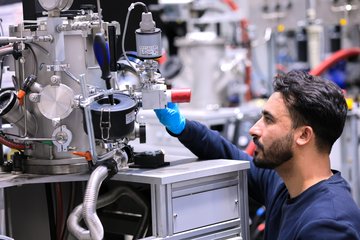All genres
221.
Journal Article
Downscaling metal-dielectric interface fracture experiments to sub-micron dimensions: A feasibility study using TEM. Surface and Coatings Technology 270, pp. 1 - 7 (2015)
222.
Journal Article
The influence of a brittle Cr interlayer on the deformation behavior of thin Cu films on flexible substrates: Experiment and model. Acta Materialia 89, pp. 278 - 289 (2015)
223.
Journal Article
Internal and external stresses: in situ TEM compression of Cu bicrystals containing a twin boundary. Scripta Materialia 100, pp. 94 - 97 (2015)
224.
Journal Article
Importance of dislocations pile-ups on the mechanical properties and the Bauschinger effect in micro cantilevers. Journal of Materials Research 30 (6), pp. 791 - 797 (2015)
225.
Journal Article
Can micro-scale fracture tests provide reliable fracture toughness values? A case study in silicon. Journal of Materials Research 30 (5), pp. 686 - 698 (2015)
226.
Journal Article
Nanostructure and mechanical behavior of metastable Cu–Cr thin films grown by molecular beam epitaxy. Acta Materialia 83, pp. 318 - 332 (2015)
227.
Journal Article
Influence of initial microstructure on thermomechanical fatigue behavior of Cu films on substrates. Microelectronic Engineering 137, pp. 5 - 10 (2015)
228.
Journal Article
Interface fracture and chemistry of a tungsten-based metallization on borophosphosilicate glass. Philosophical Magazine 95 (16-18), pp. 1967 - 1981 (2015)
229.
Journal Article
Following crack path selection in multi-film structures with weak and strong interfaces by in-situ 4-point-bending. Journal of Materials Research 30 (8), pp. 1090 - 1097 (2015)
230.
Journal Article
Cyclic bending experiments on freestanding Cu micron lines observed by EBSD. Acta Materialia 83, pp. 460 - 469 (2015)
231.
Journal Article
Study on the Atomic and Electronic Structure in CrN (VN, TiN) Films using Cs-Corrected TEM. Microscopy and Microanalysis 21 (3), pp. 2079 - 2080 (2015)
232.
Journal Article
Crack deflection in multi-layered four-point bending samples. International Journal of Fracture 190 (1-2), pp. 167 - 176 (2014)
233.
Journal Article
Temperature dependent transition of intragranular plastic to intergranular brittle failure in electrodeposited Cu micro-tensile samples. Materials Science and Engineering A: Structural Materials Properties Microstructure and Processing 618, pp. 398 - 405 (2014)
234.
Journal Article
Growth mechanism of Al2Cu precipitates during in situ TEM heating of a HPT deformed Al–3wt.%Cu alloy. Journal of Alloys and Compounds 600, pp. 43 - 50 (2014)
235.
Journal Article
Differences in deformation behavior of bicrystalline Cu micropillars containing a twin boundary or a large-angle grain boundary. Acta Materialia 73, pp. 240 - 250 (2014)
236.
Journal Article
Damage evolution during cyclic tension-tension loading of micron-sized Cu lines. Acta Materialia 67, pp. 297 - 307 (2014)
237.
Journal Article
Intermetallic phase selection during homogenisation for AA6082 alloy. Philosophical Magazine 94 (8), pp. 830 - 846 (2014)
238.
Journal Article
Transmission electron microscopy characterization of CrN films on MgO(001). Thin Solid Films 545, pp. 154 - 160 (2013)
239.
Journal Article
Elastoplastic buckling as source of misinterpretation of micropillar tests. Acta Materialia 61 (13), pp. 4996 - 5007 (2013)
240.
Journal Article
Diffusive and massive phase transformations in Ti–Al–Nb alloys-Modelling and experiments. Intermetallics 38, pp. 126 - 138 (2013)











